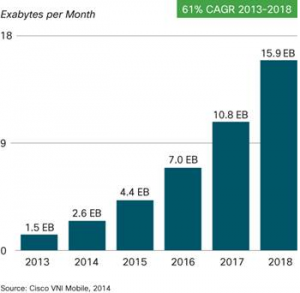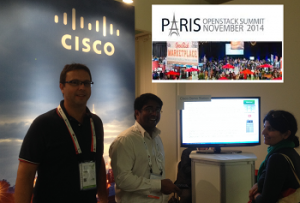Here is my first blog, which I am writing to you from Johannesburg, South Africa where I am on an assignment with a customer engagement. Based in Dubai, I’m the part of the Cloud and IT Transformation Practice in Cisco Advanced Services, and I’d like to share some of my day-to-day consulting experience with you with respect to Telco and OpenStack.
The Customer Challenge
Telcos today are entrenched in their heterogeneous, disparate and multi-vendor operating environments. Whilst their web-scale counterparts can provision services often in minutes, a telco-grade offer sometimes takes weeks for fulfilment.
At the same time, demand is changing – present day users demand for “anywhere, any-time” data and service availability, secure, and with a satisfactory SLA. Further, they demand agile services, which provision quickly and at low cost and fully align with customer needs. For example, adding a new end point to a customer VPN should take very little provisioning time.
Not only this, but with the inception of the Internet of Everything, Telcos must invest to expand their capacity. According to Cisco’s Visual Networking Index, the mobile data traffic alone is projected to grow at a compound annual growth rate (CAGR) of 61 percent (starting from 2013 all the way to 2018), reaching 15.9 exabytes per month by 2018.

Last but not least, capacity needs are dynamic – peak and non-peak usage of capacity differ by many factors, and idle capacity is a costly luxury. Neither the telco’s technical architecture nor the operating model and environment are ready today to meet the challenges of agile, high volume, fluctuating needs at an attractive cost.
New Telco Architectures
Especially when compared to hardware, software is a better environment to respond to these challenges: faster to adopt; more easily embodies new features; quickly reflects new customer configurations; scales up and down with more ease; and has little or no production cost. As a consequence, telcos try to move their environments as much to software as possible.
The next debatable item is the Software strategy: Commercial or OpenSource? Of course, Commercial Software comes with support and documentation and may be less susceptible to hackers due to its closed nature, while OpenSource offers a multitude of functions at little to no cost and is constantly updated and adapted.
To make Commercial Software more affordable for the Service Providers, vendors often suggest the “Pay As you Grow Model”. Under this business model, vendors allow Service Providers to make relatively small initial investments in capacity and/or functionality. As the SP leverages software licensing to drive core initiatives, the investment in technology is expanded incrementally if and when the business need arises.
This incremental model is often favored by businesses today as it insulates them against the downside of over-investing. For the vendor, this model promises both present and future revenue.
On the other hand, OpenSource comes with the source code which means Service Providers can have their own teams of developers and they can modify/update the contents as per the Business and Technical requirements.
Road to the OpenSource Cloud starts from Workload consolidation and then Infrastructure virtualization and then Operations Automation and then Cloud Computing and finally OpenSource Cloud so basically it’s a Journey not just a destination.
So what needs to be done here? It seems everyone is trying to move toward XaaS (everything “X” as a service) because this where cloud is popping up as the dominant way to provider infrastructure, applications and solutions – characterized by an off-premise, self-service, opex model of delivery.
But before a telco embarks itself on the path of transformation, it needs to identify its identity, i.e., what kind of services it is going to be offering. Some of the incumbent service providers are offering services such as Cloud Compute, Cloud Storage, Network enabled Cloud, Private Cloud, and VDI ….to name just a few. What about your organization?
In my next blog, I’ll continue with our approach here at Cisco and how we are helping customers. In the meanwhile, please join us at OpenStack Summit in Paris:
The OpenStack Paris Summit started November 3. In addition to the general speaking sessions, booth, demos and other events captured here, Cisco’s team members are also leading and participating in several design sessions to shape the Kilo OpenStack release.
We look forward to having some great discussions at the Summit and hope to see you there as well! Please stop by Cisco (Booth C3) and our newest acquisition, Metacloud (Booth E37). Visit us at Cisco’s OpenStack webpage for more information.
I hope you have enjoyed this blog. Please feel free to get in touch via the comments field.

Mudassir – interesting blog, thanks for sharing…two questions for you:
1) In the last year or so, what would say has been the most interesting or unexpected development among customers deploying OpenStack?
2) What do you predict the next year will look like?
Interested to hear your perspective…
Interesting Questions …
Let me address the first one by capturing some of the key challenges
1. Customers didn’t know what OpenStack can and can’t do for them.
2. Then how OpenStack can be tied with the Business because there has to be some business justification for its deployment
3. How to leverage the richness of OpenSource i.e., team of software engineers on the payroll or outsource the business
Upcoming years will be very interesting because we have helped/are helping customers in addressing the above challenges but Day 2 Support is still a Major Pain point i.e., Ok … you have deployed state of the art customized solution but there has to be someone to run and maintain it. Its one of the key areas where we should focus and offer new services in the context of “Piece of Mind”.
These are good considerations to make. SPs will want to spend time consideration their differentiation before entering the high-speed, aggressive and expensive cloud provider market.